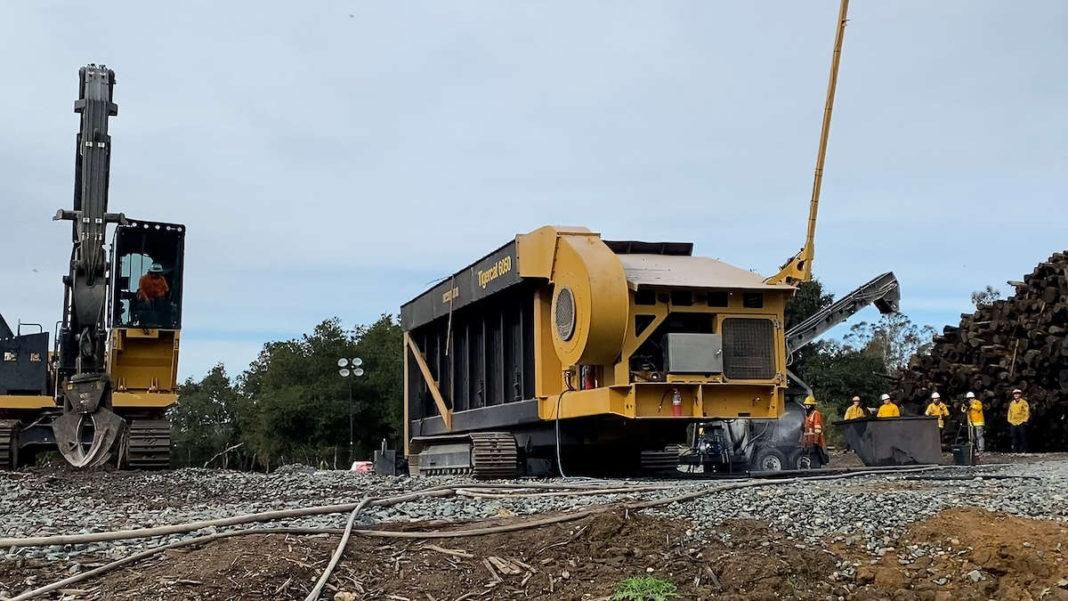The East Bay Regional Park District may have found the wildfire-fighter equivalent of Arnold Schwarzenegger’s “The Terminator.”
The most recent California drought is over. But it, and the bigger issue of ongoing climate change, left behind over 1,500 acres of dead and dying trees within the East Bay Regional Park District’s 73 parks, over 1,330 miles of trails and 125,000 acres. Potential danger from wildfires is high, especially with many of the parks and trails being close to urban centers. The damage was initially assessed in the fall of 2020.
Trees most affected included nonnative eucalyptus, and to some degree, bay and pine. “We were facing a crisis,” said EBRPD general manager Sabrina Landreth in a Park District release. “I directed staff to assess the situation quickly and come together with a plan of action, including obtaining the necessary funding to begin addressing the die-off.”
The solution was to thin the trees, taking out those dead and dying, while preserving healthy native trees such as oaks, bays and madrone. But the first hurdle was funding.
In 2021, the District approached state officials for help, and the state responded with a $10 million direct appropriation from the Legislature through Sen. Nancy Skinner, representing Berkeley, and then-Sen. Bob Wieckowski, representing Fremont. The total cost estimate to address the tree die-off issue is over $30 million.
This enabled EBRPD to make a significant start—but Fire Chief Aileen Theile was determined to find ways to reduce the damaged biomass without creating additional problems. Her background in environmental science and biology led her to explore new options. That included a pilot project in an 80-acre section of forest that was predominantly eucalyptus, near a former shooting range in Anthony Chabot Regional Park, using a machine produced by Tigercat called “The Carbonator.”
The Carbonator, EBRPD materials explain, burns organic matter at extremely high temperatures—about 1,300 degrees Fahrenheit—using very little oxygen to dispose of vegetation. The process is called “pyrolysis.” Emitting almost no smoke, its use results in very low greenhouse gas emissions. “The Carbonator aligned with our objectives,” said Theile in a phone interview. “It would sequester carbon, with no semis on the road carrying timber.”
Germany, Canada and the Nordic countries have been using pyrolysis for years, and The Carbonator was already being used successfully by “Big Timber in the Sierra Nevadas,” she said. But the technology had never been used in a metropolitan area for biomass disposal on this scale.
“The GM had enough faith in me to OK [the pilot project],” said Theile. So, in 2023, The Carbonator was put to work in the chosen area in Anthony Chabot. Along with removing the selected trees, it also began burning “ladder fuels,” which are “vegetation and plant debris that can provide a route for flames on the ground to ignite progressively higher levels of vegetation and reach the tree canopy,” EBRPD materials explain.
Theile, quoted in an article from the Park District’s website, said, “If the fire goes in the treetops, embers will be thrown aloft and cast into the wind, which means we end up chasing the fire. That’s how conflagrations like the Camp Fire, which in 2018 killed 85 people and destroyed two towns in Butte County, became so dangerous and so difficult to fight.”
The pilot program, completed in March 2023, was deemed a resounding success. Data and results were shared with the state and “other agencies facing similar challenges,” materials state. Yet another advantage of The Carbonator is that the material produced in its process, called biochar, has multiple uses. Essentially a very porous charcoal, it can be used as a soil enhancer, for example.
The Carbonator is now at work on a major fuels reduction project in a total of 365 acres in the same park. This project is using $7.5 million of the $10 million direct appropriation from the state Legislature, plus federal funds of $1.5 million secured by U.S. Sen. Alex Padilla (CA).
At the time of the interview, 4,918 tons of dead and drought-damaged trees had been removed, creating 491 tons of biochar, according to Theile.
The website climatehubs.usda.gov describes the research now underway by the USDA Forest Service, USDA Agricultural Research Service and the Environmental Protection Agency, to “provide insight into how effective biochar”—a known binding agent, said Theile—“is at binding with heavy metals and chemicals from agricultural and road runoff for the purpose of environmental remediation.”
The same site noted that proven biochar applications include improving soil health, raising soil pH, remediating polluted soils, sequestering carbon, lowering greenhouse gas emissions and improving soil moisture.
The Park District is already using biochar in several of these ways, Theile said, including soil enhancement at Ardenwood Historic Farm in Fremont. Located on the former estate of George and Clara Patterson, whose family farmed there for more than 100 years, the site has been operated as a functioning turn-of-the-last-century farm by EBRPD since 1985.
Biochar is also being used to stabilize hillsides, in parks such El Sobrante’s Wildcat Canyon, and potentially in developing “biosoils” that can be used to clean runoff during rains such as the East Bay has experienced in 2024.
The Park District’s success with using The Carbonator has not gone unnoticed by other agencies. At the pilot project’s start, “BAAQMD (Bay Area Air Quality Management District) gave permission for a 24-hour burn,” said Theile, testing the level of emissions produced. BAAQMD has continued to inspect during the project and has been impressed by the results, she said. PG&E has also sent representatives to view the process and results.
This all ties into EBRPD’s stated goal of being an innovative leader in land management, including wildfire prevention. “As the largest regional park district of its kind in the nation and a local wildfire prevention leader, we knew we needed to lead the way in finding solutions,” said Landreth in a Park District article.
Theile noted that EBRPD has the opportunity to “open the door” to new and effective ways to keep wildfire danger at bay. The Carbonator, she said, will definitely “be back” as the Park District explores expanding its use to other sites.
“We anticipate employing it on other projects,” Theile said. At the same time, she pointed out, “We are sharing information, and figuring out all the tools we can use in the tool box.”
Meanwhile, for obvious safety reasons, park visitors will not be allowed to see The Carbonator at work. The site is definitely a hard-hat-only zone, Theile said. But a visit to Ardenwood Historic Farm could begin to demonstrate how the biochar can contribute to a flourishing crop cycle. For information about Ardenwood activities, visit ebparks.org/parks/ardenwood.
Even The Terminator himself would be impressed.
The East Bay Regional Park District spans Alameda and Contra Costa counties in the San Francisco Bay Area. The District has its own fire department and fuels management crew. For more information, visit www.ebparks.org













